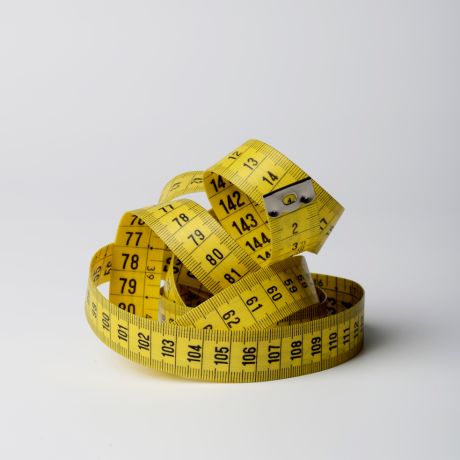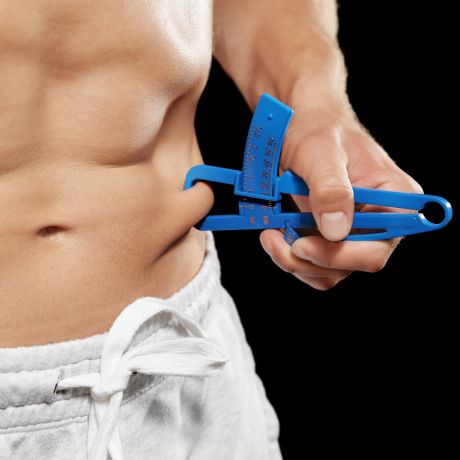
Recognizing improvements as a bodybuilder can be exceedingly difficult. You work hard in the gym and strictly monitor what goes in your mouth, yet your physique appears unchanged. Because you see yourself so often, it’s hard to know whether you’re making gains, stagnating, or even going backward.
That’s why you need an objective method to assess your body. Standing on a scale will tell you how much you weigh but not how much of that weight is fat and how much is muscle. Body fat percentage analysis will give you your body composition, but it won’t tell you anything about your symmetry and proportion or your overall body shape.
For that, you need to take body measurements regularly. Taking body measurements will let you know whether you’re adding mass to specific muscle groups, how balanced your left and right muscles are, and how ideally proportioned your physique is. But it will only do those things if you know how to take body measurements the right way.
Read on to discover how to take bodybuilding measurements like a pro and how your measurements compare to ideal proportions.
Why Take Body Measurements
Bodybuilding success is about more than adding slabs of muscle to your body. It’s about sculpting a living work of art where your individual muscles are ideally proportioned and symmetrically balanced. Doing that takes a lot of dedication, perseverance, and hard work. And it requires careful monitoring.
Body measurements provide you with data that you can’t get from the scale. The scale will give you a raw weight but tell you nothing about the distribution of that weight or the ratio of fat to muscle.
Your body fat percentage is a valuable data point, but it, too, is limited. From it, you can work out your amount of lean body mass but not how that mass is proportioned on your physique.
There’s a scene in Pumping Iron where Arnold Schwarzenegger compares bodybuilding to a sculptor adding clay to a sculpture in order to create the perfect end product. Arnie emphasizes the importance of proportion, saying he would never exercise one side of his body more than the other for fear of destroying his balance and symmetry.
?If you want to try and mold your body like Arnold, check out his Chest Workout.
There’s only one way to truly know if your body is developing symmetrically and in proportion: regularly taking your measurements. Doing so will tell you if your upper arms are in proportion to your calves, whether your right quad is symmetrical with your left, and if you’re achieving the ideal lat-to-waist v-taper.
This feedback allows you to adjust your training to correct any issues that become apparent. If your right bicep is half an inch bigger than your left, you may have to start training with dumbbells instead of a barbell to bring up the lagging side. And if your quads are lagging behind proportionally with your upper body, you might have to start prioritizing them with more targeted training.

How to Take Bodybuilding Measurements
Taking your measurements requires consistency, accuracy, and attention to detail. Adding size to your muscles is a slow process, measured in fractions of an inch. So, it’s vital that your measurements are taken as accurately as possible and the same way each time.
To prepare for taking your measurements, you should acquire a measuring tape that is flexible and durable. It should have clear markings that are divided into tenths of an inch. Ideally, the measuring tape should mark units in both metric and imperial readings. Choose a flexible vinyl or cloth measuring tape.
Find a well-lit area for measuring body parts. If possible, stand in front of a full-length mirror so you can see that you are measuring both sides of your body the same way.
Men should wear nothing but workout trunks or underwear, while women should wear a sports bra and shorts.
Ask a trusted friend to help take your measurements. Explain to them the importance of keeping the tape measurement straight all the way around the body.
Do not exercise prior to taking your measurements. Doing so will unnaturally pump up the worked body parts, engorging them with blood and making them temporarily bigger than they are in their normal state.
Here is where you should measure your body:
Chest
Stand with your arms outstretched so that your partner can circle the tape measure around your chest, just above the nipple line. Now lower your arms to your sides. Breathe out just before your measurement is taken. It is critical that the tape remain parallel to the floor all the way around.
Upper arm (flexed)
You will measure both arms in the flexed bicep position. In the flexed position, your arm should be bent at a right angle. Measure the fullest part of the bicep.
Forearms
You need to measure both forearms. Take the measurement at the widest part of the forearm, which should be halfway between the elbow and wrist. Make sure that you measure the same point on each arm.
Shoulders
Stand with your arms at your sides and have your partners run the tape measure around your shoulders at the widest point. Resist the temptation to expand your chest and shoulders. Rather, stand relaxed so your partner can get an accurate recording.
Waist
Extend your arms out to the side to allow your partner to wrap the tape around your waist at the level of your navel. Now, bring your arms back to your sides. Ensure that the tape is level all the way around. Do not suck in your gut; stand naturally relaxed.
Thighs
Stand with your feet slightly wider than hip-width apart and your feet firmly planted on the floor. Have your partner kneel alongside you and wrap the tape around the mid-thigh. Do not flex your quads. Measure both legs, being sure to put the tape around the same part of each thigh.
Calves
Measure both calves around their thickest part. For this measurement, you should flex your calves.
![]()
Tracking Progress Over Time
You should take your measurements regularly enough to get a good handle on the changes that are taking place with your body. But you don’t want it to be so frequent that you don’t see any changes, as this could be demoralizing.
I recommend that you take your measurements once per month. Do it on the same day of the month and the same time. If possible, use the same partner to do the measuring. This will make it more likely that the measurements will be taken in a uniform manner. You should also wear the same outfit each time.
We’ve created this convenient image for you to print out and help keep track of how your measurements are progressing.
Another great way to track progress is to take pictures and we go into great detail into taking professional-level progress pictures here.
How to Assess Your Bodybuilding Measurements
There are three key ways to assess your bodybuilding measurements:
- Comparing the measurement to previous results.
- Comparing the left and right sides of a muscle.
- Comparing your measurements to ideal proportions and ratios.
1. Comparing Measurements to Previous Results
When you are measuring your muscles on a monthly basis, you need to be realistic about the likelihood of making gains. The longer you’ve been training, the smaller your progress increments will be.
If you have been working out for less than 18 months and are training intensely while maintaining a protein-rich daily caloric surplus, you can expect to gain one or more tenths of an inch every month to each measurement.
If you’ve been training between 18 months and three years, your results will come more slowly. A gain of one-tenth of an inch in a month is a great result. Experienced trainers with more than three years of gym time under their belt can expect less frequent gains.
2. Comparing the Left & Right Sides of a Muscle
Your goal as a bodybuilder should be to achieve symmetrical development of your body. That means that the left and right sides of a muscle should have similar measurements. Unbalanced muscle development will throw off your body shape, regardless of how big your individual muscles may be.
The muscles that are affected here are the upper arms, forearms, thighs, and calves. If you find that you have a disparity between the left and right sides with any of these muscles, you need to focus on unilateral training in order to bring up the lagging body part.
3. Comparing Measurements to Ideal Proportions & Ratios
Achieving physical perfection has been the obsession of many people over the centuries. The ancient Greeks were especially enamored with the subject, as seen by the many statues from that time that are still in existence.
Three ideals have emerged as the basis for the perfect male body:
The Golden Ratio
The golden ratio is an aesthetically pleasing pattern that is found in nature, art, and architecture. That ratio is 1.618:1. The golden ratio is used in reference to humans to indicate the ideal proportions of such things as the length of the forearm to the hand and the length of the face to its width.
The golden ratio can be applied to body proportions, such as the chest-to-waist differential. According to the ratio, a person with a waist measurement of 32 inches should have a chest measurement of 52 inches. Keep in mind that this is the perfect ideal and may not be realistic for everyone.
The Vitruvian Man
In the 1490s, Leonardo Da Vinci created his famous Vitruvian Man drawing, based on the work of ancient Roman architect Vitruvius. The image shows a man with his arms and legs outstretched in two positions and represents the ideal proportions of the male human body.
The Greek Ideal
The Greek Ideal represents the culmination of the ancient Greek obsession with the male physical ideal. It represents a combination of physical beauty and athleticism. The ideal is based on specific ratios between body parts and bones.
From these sources, we are able to arrive at the following ideal proportions and ratios that you can compare your measurements to:
- Upper arm measurement should be 2.52 X wrist measurement
- Chest measurement should be 1.48 X hip measurement
- Waist measurement should be .86 X hip bone measurement
- Thigh measurement should be 1.75 X knee measurement
- Calf measurement should be 1.92 X ankle measurement
As an example of the above, a man with a wrist measurement of 7.1 inches needs a flexed upper arm measurement of 18 inches to have perfect arm proportions.
One famous bodybuilder of old who came as close to a perfectly proportioned physique as anyone ever has was Steve Reeves. Here are Steve’s measurements at his prime:
- Chest = 54 inches
- Upper Arms =18.4 inches
- Waist = 30 inches
- Thighs = 27 inches
- Calves = 18 inches

Why You Should Also Assess Body Fat Percentage
While your body measurements are a great way to know what’s happening with your individual body parts, they will not tell you how much of that body part is muscle and how much is fat. Nor will it indicate body composition changes. For that, you need to know your body fat percentage.
That’s why I recommend having your body fat percentage taken on a monthly basis at the same time as your body measurements. The easiest way to do so is to invest in a set of scales that measure your body fat percentage with the aid of bioelectrical impedance analysis (BIA). You can invest in a quality scale for less than a hundred dollars.
Adjusting Your Workouts Based on Your Measurement Results
By taking your measurements on a monthly basis, you will have an objective gauge to assess whether your workouts are producing the results you want. If you find that your left and right muscles are not symmetrical, you should adjust your training so that you are working unilaterally.
If you’ve been training with a barbell, it’s likely that your strongest (and largest) side is taking more than 50% of the load of the resistance. By switching to dumbbells, you will be forcing each side to carry its own weight. Over time, the smaller, weaker side will come up to match the other side.
If you find that your upper and lower body are out of proportion, you should consider cutting back the frequency of training your dominant body parts. You might train the dominant part once per week and the lagging part twice per week.
In the rare case that your measurements have actually gone down, you need to take at least a full week off from training. It is likely that you are in an overtrained state, so a week of complete rest will do you good. Then, reassess your training frequency. Experiment with training a body part once per week for a month and then recheck your measurements.
You should also check your caloric and protein intake if you are losing muscle size. Make sure that you are achieving a 250-500 calorie surplus every day to give your muscle cells the material they need to get bigger.
We have an entire article dedicated to help fix muscle imbalances and asymmetries.
Wrap Up
Taking body measurements once a month is a habit that every bodybuilder should develop. Doing so will provide an objective assessment of how successful your training and nutrition program is.
Follow our guidelines to ensure that you’re taking measurements that are as accurate as possible. Then, use that feedback to adjust your program as you gain muscle and work towards getting as close to your ideal proportions as you can.





